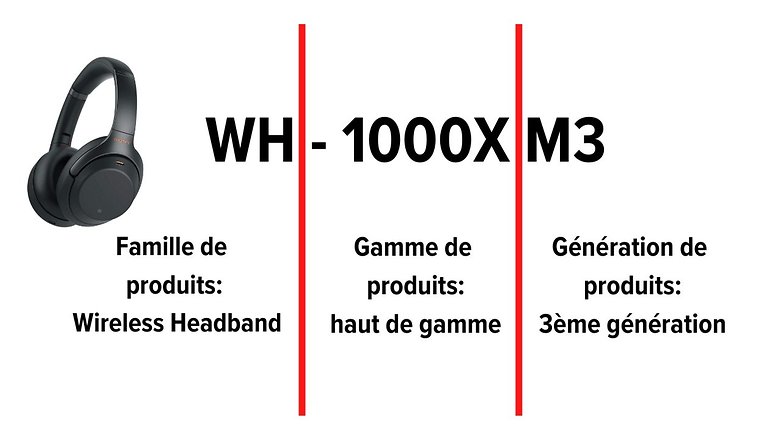Sony's headphones and earbuds nomenclature decrypted


Read in other languages:
WH-1000XM3, WF-1000XM3 or MDR. Every technophile who delves into the world of audio would know that these are references of Sony headphones and true wireless earbuds which are market-leading products. However, only a select few know what these cryptic acronyms stand for, as Sony has not communicated the idea behind such naming conventions, while information available on the Internet proved to be incomplete at best or even erroneous.
Having reviewed some of these products, it would be an intelligent guess that the "W" in "WH" refers to "wireless" or Bluetooth connectivity. However, I dare venture that trying to decrypt what WISP510B stands for will most probably result in a brain cramp of sorts. While Sony is not the only brand in the market to use acronyms for its product names, it would be nice to understand the reason behind their naming convention of Sony headphones and earphones, especially when you have plenty of options in the market.
Read also: New affordable Sony headphones that deliver great audio
We decided to dive into the matter and got in touch with the company, who redirected us to Jean-Denis Favier, product manager at Sony France for the headphones segment. "I don't have any explanation on the why or the how of this nomenclature", began the product manager, who was amused by our request and did his level best to decipher these code names for us. It must be said, however, that there is a method to the madness and our lexicon ought to allow us to better identify Sony's audio product lines and families in the future.
A system that is not based on price range
"Each first name refers to a form factor, and not to its price range," said Jean-Denis Favier. "Acronyms indicate whether you're dealing with a C-arm (helmet) or I.T., wired or Bluetooth headset."
Concerning the wired segment, we have questions of our own, especially models whose name begins with MDR (Micro Dynamic Receiver). This acronym refers to the dynamic range, which is the ratio between the lowest and highest levels of a sound. When it comes to wired models, the in-ears have a name that begins with IER, for "In-ear" or intra-auricular.
Diving deeper into the heart of the matter: wireless headsets and headphones. Where Bluetooth models are concerned, the headsets are grouped under the acronym WH. "WH" stands for "Wireless - no, not Headphones, but Headband", or wireless headband in short. Bluetooth I.D.s stands for "Wireless In-Ear."
True wireless headphones have a calling card of WF which stands for..."True Wireless". Go figure! We have the "W" for wireless, but we are still in the dark as to what the "F" stands, and unsurprisingly, neither does Jean-Denis Favier. Remember, we did not promise that all of it made sense, but an AndroidPit reader did drop a hint that the acronym could point to "Wire-Free".
Sony acronyms for Bluetooth
| Acronym | Definition | Type of product |
|---|---|---|
| WH | Wireless Headband | Bluetooth headset |
| WI | Wireless In-Ear | Bluetooth In-ears |
| WF | True Wireless | In-ears and no neckband (100% wireless) |
The logic behind this lexicon: some concrete examples
Well, you must have experienced a headache dealing with all these intellectual gymnastics and their accompanying definitions. However in reality, there is logic behind this seemingly confused lexicon. Certain letters and numbers are indicators of the price range, on-board technologies, or simply the product color. Let's take a look at a few concrete examples.
Let's begin with Sony's star product, the WH-1000XM3. Thanks to Jean-Denis Favier, we now know that the WH refers to the family of products that is classified as a Bluetooth headset. "The mention 1000X refers to the product range, which is the high-end range at Sony," said the Sony manager. "We first released the MDR-1000X (MDR, which was wired), the WH-1000XM2, and then the XM3." We can finally deduce that the "M3" segment refers to the product generation.
We are now able to make our way around this naming convention better. One could even break it down as such:

Take note that this is not a general rule that applies to all models. There are many other acronyms that refer to more than just the product type. In fact, certain acronyms point to a particular technology that has been embedded in the product This applies to the WH-CH710N, where the "N" refers to "Noise Canceling" which happens to be the active noise reduction technology. As for "CH", Jean-Denis Favier has absolutely no idea.
These headphones were announced at the beginning of April, accompanied by a couple of new earphones that will replace the outgoing WH-CH510, where it will be cheaper and misses out on active noise reduction. Here, it is important to note that the number does not always translate to an upgrade, with the 710 is more premium than the 510, and hence, costing more. Then again, this is not meant to be an indication of the pricing structure, but leans more toward the technical specifications of the product.
One of Sony's other recently announced products would be the WI-SP510 wireless in-ear earphones, also known as "WI" for wireless in-ear (WI) Bluetooth headphones. "However, the SP refers to 'Sport'," says Favier. As for the 510, we can guess that happens to be the entry-level model, which is confirmed by its €80 ($87) selling price. The XB in the WF-XB700 is based on Sony's Xtra Bass technology, which is a sound enhancement that allows for a deeper bass rendering without sacrificing on its treble.
Finally, the letters can also simply mean the color of a given product. For example, the "B" at the end of the name of the Sony WH-CH710NB headphones does not refer to any onboard technology or any product range, but only to the color of the headphones: black.
There you have it, you now have valuable knowledge that 99% of the Sony fanbase does not know. I hope this article will be able to help you figure out Sony's excellent audio catalog in a clearer manner. The lexicon itself is not exhaustive, and it does not evoke for example the brand prestige of the "Signature" range from Sony. However, many make up the MDR-Z1R. Perhaps it is "Z" for "Zignature"?



















